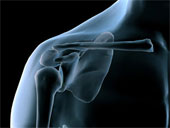As a Neuromuscular Therapist, how do I think about these rotator cuff and shoulder pains?
 The shoulder has only one small joint holding it to the skeleton at the inside edge of the collar bone where it connects to the breastbone (sternoclavicular joint). The stability of the shoulder depends on strong ligaments and on balance of the muscles that move the arm in the joint. If one muscle is too tight it can throw off the joint alignment.
The shoulder has only one small joint holding it to the skeleton at the inside edge of the collar bone where it connects to the breastbone (sternoclavicular joint). The stability of the shoulder depends on strong ligaments and on balance of the muscles that move the arm in the joint. If one muscle is too tight it can throw off the joint alignment.
Causes of pain with a muscular origin can be local ischemia, tension in the joint, Trigger Points referring to the shoulder, impingement of the supraspinatus tendon, and inflammation of the subaccromial bursa.
Local ischemia: A shortage of oxygen to a muscle causes pain, just like an ischemic event in the heart. When muscles are chronically tight, the blood flow is reduced. Blood carries oxygen and nutrients to keep the muscles healthy. Blood and lymph circulation removes waste products that cause pain. So if blood isn’t getting to a muscle, it can’t be healthy. The lack of oxygen combined with irritating waste products will cause pain.
Joint tension: When the muscles that cross a joint are tight, the joint itself will be tight. That tension can cause pain. All joints have nerves to tell the body when something is wrong there. When there is too much tension, the nerves fire off in warning. The tension also causes the bony parts of the joint to rub together with movement, leading to friction and inflammation.
Trigger Points: Pain referred into the shoulder joint or to the muscles in the front or back of the shoulder can come from many muscles, but mostly from those in the upper extremity and upper torso. Only Trigger Points from the four rotator cuff muscles are shown here. Neuromuscular Therapists are especially interested in deactivating Trigger Points because without doing so, the constant hyperactivity will continue to cause tension and pain.

Impingement: The supraspinatus tendon slides back and forth under the outer tip of your shoulder whenever you raise and lower your arm to the side. When the joint is tight, this tendon rubs on the bones between which it travels and can cause inflammation and even fraying. The little supraspinatus is a key player in rotator cuff problems, so important that it can make the whole shoulder girdle ischemic.
Bursitis: When impingement happens, the bursal sac placed there to protect the tendon from injury can get inflammed and swollen from the friction. Releasing the tension in the rotator cuff muscles and icing to reduce the inflammation can solve the problem.
Correction of rotator cuff and shoulder pain includes Neuromuscular Therapy treatment of many muscles, careful targeted Active Isolated Stretching, a home program of self-applied pressure to Trigger Points, icing, elimination of overloading activities, and correction of perpetuating factors like sleeping positions.